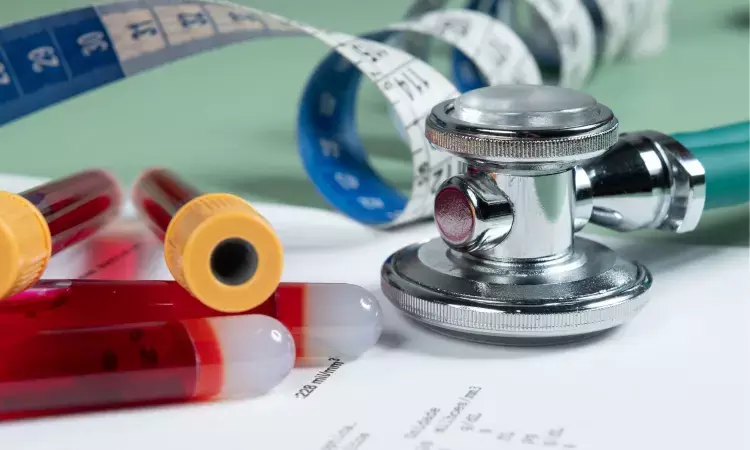- Home
- Medical news & Guidelines
- Anesthesiology
- Cardiology and CTVS
- Critical Care
- Dentistry
- Dermatology
- Diabetes and Endocrinology
- ENT
- Gastroenterology
- Medicine
- Nephrology
- Neurology
- Obstretics-Gynaecology
- Oncology
- Ophthalmology
- Orthopaedics
- Pediatrics-Neonatology
- Psychiatry
- Pulmonology
- Radiology
- Surgery
- Urology
- Laboratory Medicine
- Diet
- Nursing
- Paramedical
- Physiotherapy
- Health news
- Fact Check
- Bone Health Fact Check
- Brain Health Fact Check
- Cancer Related Fact Check
- Child Care Fact Check
- Dental and oral health fact check
- Diabetes and metabolic health fact check
- Diet and Nutrition Fact Check
- Eye and ENT Care Fact Check
- Fitness fact check
- Gut health fact check
- Heart health fact check
- Kidney health fact check
- Medical education fact check
- Men's health fact check
- Respiratory fact check
- Skin and hair care fact check
- Vaccine and Immunization fact check
- Women's health fact check
- AYUSH
- State News
- Andaman and Nicobar Islands
- Andhra Pradesh
- Arunachal Pradesh
- Assam
- Bihar
- Chandigarh
- Chattisgarh
- Dadra and Nagar Haveli
- Daman and Diu
- Delhi
- Goa
- Gujarat
- Haryana
- Himachal Pradesh
- Jammu & Kashmir
- Jharkhand
- Karnataka
- Kerala
- Ladakh
- Lakshadweep
- Madhya Pradesh
- Maharashtra
- Manipur
- Meghalaya
- Mizoram
- Nagaland
- Odisha
- Puducherry
- Punjab
- Rajasthan
- Sikkim
- Tamil Nadu
- Telangana
- Tripura
- Uttar Pradesh
- Uttrakhand
- West Bengal
- Medical Education
- Industry
Increased non-HDL-C and waist circumference significant predictors of Metabolic syndrome

Metabolic syndrome (MetS) is a group of cardiovascular risk factors. This includes glucose disorders accompanied by dyslipidemia, increasing the risk of heart disease and type 2 diabetes mellitus. Non-high-density lipoprotein-cholesterol (non-HDL-C) is a potential biomarker for MetS. According to a recent Lipids in Health and Disease study, researchers have concluded that Elevated non-HDL-C and increased waist circumference (WC) are significant predictors of MetS in Iranians. Those with elevated non-HDL-C were exposed to an approximately 42% increased MetS risk in their lifetime.
This study included 4684 individuals from the MASHAD (Mashhad Stroke and Heart Atherosclerotic Disorder) cohort. These patients were followed for ten years. Researchers examined the association between non-HDL-C and MetS incidence. Additionally, the contribution of individual MetS components to the overall burden was evaluated. The main objective of this study was to assess the non-HDL-C role in the early diagnosis of MetS in the Iranian population through a longitudinal study.
The key results of the study are:
- A total of 1599 subjects developed MetS, while 3085 did not.
- There was an association between Non-HDL-C levels ≥ 130 and a 42% higher risk of developing MetS (RR: 1.42).
- Considering MetS components, elevated WC had the strongest association with MetS incidence (RR, 2.32), whereas triglyceride (TG) levels ≥ 150 mg/dL had the weakest association (RR, 1.23).
- Higher HDL-C levels were 20% protective against the risk of MetS (RR, 0.8).
- There was no significant link between fasting blood glucose (FBG) levels ≥ 100 mg/dL and MetS burden.
- Systolic BP levels ≥ 130 mmHg or diastolic BP levels ≥ 85 mmHg increased the risk of MetS incidence (RR, 1.25)
To mitigate the risk of MetS development, strategies targeting non-HDL-C levels and weight loss should be emphasized.
Elevated WC increases the risk of metabolic disorders by 2.3-fold, they noted. Weight loss strategies, specifically abdominal fat management, can benefit subjects susceptible to MetS development.
Our study addressed the research gap regarding the association of non-HDL-C with the incidence of MetS and its components over a long follow-up period, they said. As acknowledged, the study was supported by Mashhad University of Medical Sciences.
Reference:
Vazirian, Fatemeh, et al. "Non-HDL Cholesterol and Long-term Follow-up Outcomes in Patients With Metabolic Syndrome." Lipids in Health and Disease, vol. 22, no. 1, 2023, p. 165.
BDS, MDS in Periodontics and Implantology
Dr. Aditi Yadav is a BDS, MDS in Periodontics and Implantology. She has a clinical experience of 5 years as a laser dental surgeon. She also has a Diploma in clinical research and pharmacovigilance and is a Certified data scientist. She is currently working as a content developer in e-health services. Dr. Yadav has a keen interest in Medical Journalism and is actively involved in Medical Research writing.
Dr Kamal Kant Kohli-MBBS, DTCD- a chest specialist with more than 30 years of practice and a flair for writing clinical articles, Dr Kamal Kant Kohli joined Medical Dialogues as a Chief Editor of Medical News. Besides writing articles, as an editor, he proofreads and verifies all the medical content published on Medical Dialogues including those coming from journals, studies,medical conferences,guidelines etc. Email: drkohli@medicaldialogues.in. Contact no. 011-43720751


